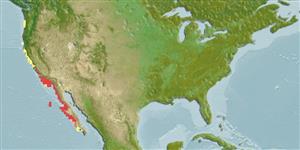Common names from other countries
Teleostei (teleosts) >
Perciformes/Serranoidei (Groupers) >
Serranidae (Sea basses: groupers and fairy basslets)
Etymology: Paralabrax: Greek, para = the side of + Greek, labrax, -akos = a fish, Dicentrarchus labrax (Ref. 45335).
More on author: Girard.
Environment: milieu / climate zone / depth range / distribution range
Ecology
Marine; benthopelagic; depth range 1 - 61 m (Ref. 96339), usually 3 - 25 m (Ref. 32351). Subtropical; 48°N - 23°N, 126°W - 109°W
Eastern Pacific: Columbia River in Washington, USA to southern Baja California, Mexico.
Size / Weight / Age
Maturity: Lm ? range ? - ? cm
Max length : 72.0 cm TL male/unsexed; (Ref. 2850); max. published weight: 7.0 kg (Ref. 9342); max. reported age: 34 years (Ref. 56049)
Usually found in or near kelp beds, shallow water and to about 50 m but mostly from 2.4-21m . Found throughout water column. Large specimens usually occur in deeper water. Juveniles feed on benthic invertebrates (especially crustaceans); adults feed on fishes and cephalopods (Ref.9342). Both juveniles and adults may feed on plankton when abundant (Ref.9342). Pelagic spawners (Ref. 56049). Also caught with troll lines (Ref. 9342). Excellent food fish and an important game fish (Ref. 9342).
Pelagic spawner (Ref. 56049). Spawning aggregations are a significant component of the reproductive behavior of this species (Ref. 59326). Also Ref. 103751.
Eschmeyer, W.N., E.S. Herald and H. Hammann, 1983. A field guide to Pacific coast fishes of North America. Boston (MA, USA): Houghton Mifflin Company. xii+336 p. (Ref. 2850)
IUCN Red List Status (Ref. 130435)
CITES (Ref. 128078)
Not Evaluated
Threat to humans
Harmless
Human uses
Fisheries: commercial; gamefish: yes
More information
ReferencesAquacultureAquaculture profileStrainsGeneticsElectrophoresesHeritabilityDiseasesProcessingMass conversion
Tools
Special reports
Download XML
Internet sources
Estimates based on models
Preferred temperature (Ref.
115969): 12 - 20.1, mean 14.8 (based on 12 cells).
Phylogenetic diversity index (Ref.
82804): PD
50 = 0.5020 [Uniqueness, from 0.5 = low to 2.0 = high].
Bayesian length-weight: a=0.00955 (0.00454 - 0.02011), b=3.05 (2.88 - 3.22), in cm Total Length, based on LWR estimates for this species & Genus-body shape (Ref.
93245).
Trophic level (Ref.
69278): 3.9 ±0.4 se; based on diet studies.
Resilience (Ref.
120179): Low, minimum population doubling time 4.5 - 14 years (K=0.10; tm=2.5; tmax=34).
Fishing Vulnerability (Ref.
59153): High to very high vulnerability (67 of 100).
